THE $2.3 billion new Royal Adelaide Hospital is far more than just a new version of the beloved Royal Adelaide Hospital whose roots date to 1840.
New models of care, extensive use of natural light and fresh air, advanced technology and use of robotics represent a new approach to patient care at the new Royal Adelaide Hospital.
It is light years from Adelaide’s founding, when the first Colonial Surgeon, Dr Thomas Young Cotter, arrived on January, 12, 1837, to discover his first three patients camped in filth under an old sail with no food or care, relying on the charity of passers-by.
A tiny hut was turned into the Colonial Infirmary, followed by a leaky thatch cottage — both on North Tce — then a building in the west parklands and, finally, on July 15, 1840, Governor George Gawler laid the foundation stone of Adelaide Hospital. “The residents of Adelaide showed as little interest in this function as they had in subscribing to the cost of the building,” records of the event report.
The building in the parklands to the north of Botanic Rd near Hackney Rd opened in early 1841 and provided accommodation for 30 patients in three wards, two rooms for staff and a central room which doubled as a dining room and operating theatre. There was no kitchen or cook, nor any trained nurses. It was expected to serve the community for many years but, within a decade, the growing population made it inadequate.
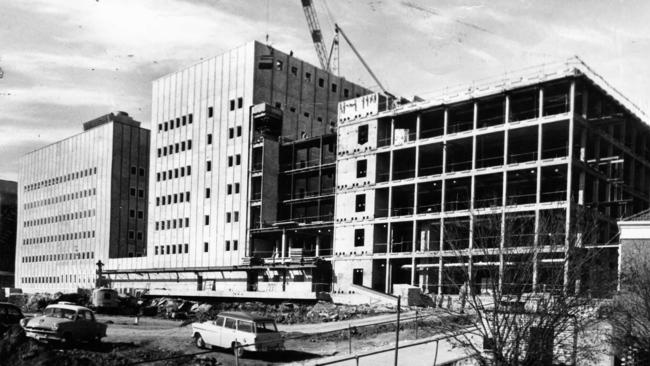
In 1850, it was decided to build a new hospital on the site of the old RAH but economic trouble caused by the exodus to the Victorian gold rush delayed construction.
The second Adelaide Hospital was built on North Tce in 1855-56, and the old building was used to increase accommodation in the nearby Lunatic Asylum. It then became the Consumptive Home and Cancer Block before being closed in 1931 and demolished in 1938.
The new Adelaide Hospital’s west wing had eight wards, four on each floor, while the central block had a surgery, a dispensary and quarters for the house surgeon.
The east wing was built in 1866-67 and provided four extra wards, two on each floor, some bedrooms, some padded rooms and a nurses’ dining room, which also did duty as a chapel.
Several additions followed — in a footnote to vastly changed times, RAH records show that, in 1877, Ovariotonomy Cottage opened to remove ovaries of women suffering “menstrual madness” and nymphomania.
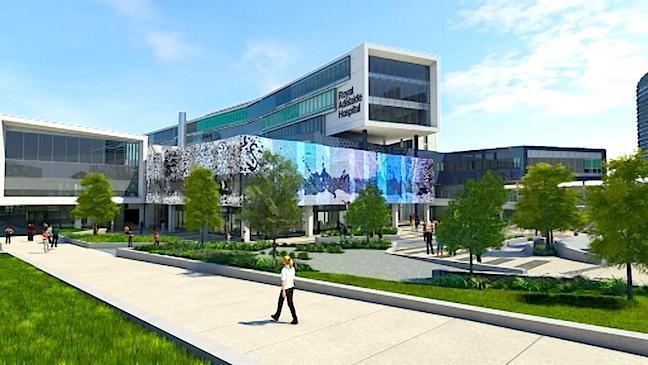
In his History of the Royal Adelaide Hospital 1840-1990, the late J. Estcourt Hughes, Emeritus Surgeon, RAH, records: “When the first Adelaide Hospital was opened, anaesthesia was not yet available to medical practice, and when its successor was opened in 1856, Lister’s epoch-making work on antiseptic in surgery was still a decade away.
“The discovery of X-rays in 1895, and the continuous advance of radiology and radiotherapy since then have necessitated the installation of equipment for which accommodation has had to be provided.
“Pathology ... has made tremendous advances also, and has demanded increasing space and facilities.
“When the rebuilding of the Royal Adelaide Hospital was under discussion in the 1950s, there was a total of 47 buildings on the site and there were 32 wards in the hospital.”

A century after overcrowding and waiting lists were a problem at the first Adelaide Hospital, little had changed. “By 1950, it became apparent that the demands of the hospital had increased to such a degree that the number of beds available was inadequate, and that the condition of the buildings and services in the older parts of the hospital were unacceptable by modern standards,” Mr Hughes wrote.
“The length of the waiting lists was also causing concern, and does not seem to have been resolved satisfactorily even today.”
The RAH was largely rebuilt on site following the “great demolition” of 1963. Its most recent rebuild was put on hold and the decision made to build an entirely new hospital on a greenfield site.
Now, the new Royal Adelaide Hospital opens at a time of changing medical practices, constantly updated technology, the new demographics of an ageing population with chronic conditions, high public expectations and the usual budget constraints. It is light years away from a shelter under an old sail, a leaky hut, dormitory wards and its other predecessors, including the old RAH.
In short
LAND
The old RAH is on a 7ha site with 0.6ha of green space; the new RAH is on a 10ha site with 3.8ha of green space.
BEDS
The RAH has 650 overnight beds and 30 same-day beds; new RAH has 700 overnight beds each in single rooms with ensuites and a lounge that can be used as a bed for a carer to stay overnight, and 100 same-day beds. All rooms also have windows that open for fresh air, light and views, and bedside technology for entertainment and food orders. Windows are low to maximise views for patients in bed. There is a 40-bed Mental Health Unit.
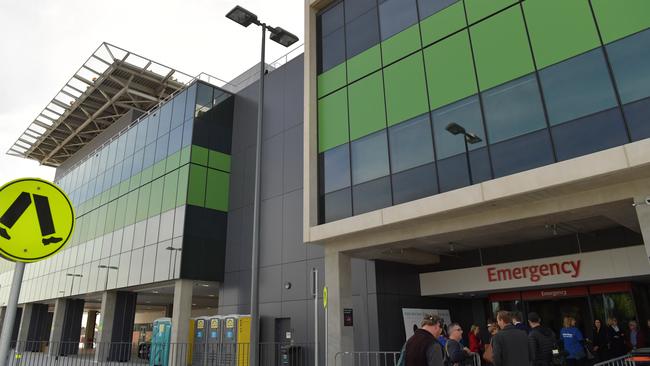
EMERGENCY DEPARTMENT
The old RAH has treatment capacity of 59 with curtained cubicles and four resuscitation rooms; new RAH has treatment capacity of more than 70 with sliding glass-doored cubicles and eight resuscitation rooms. Some ambulance arrivals will bypass the general emergency entrance and all arrivals will be triaged on arrival and directed onwards, rather than being stuck in the waiting room.
INTENSIVE CARE
The old hospital has 42 ICU bed capacity; new RAH has 60 ICU bed capacity including quarantine rooms for infectious diseases.
HELICOPTERS
The RAH has a helipad for one helicopter; new RAH has a helipad that can fit two helicopters.
OPERATING ROOMS
The old RAH has 35 operating/procedure rooms, only one at 65 sqm; new RAH has 40 “technical suites”, all of them 65 sqm.
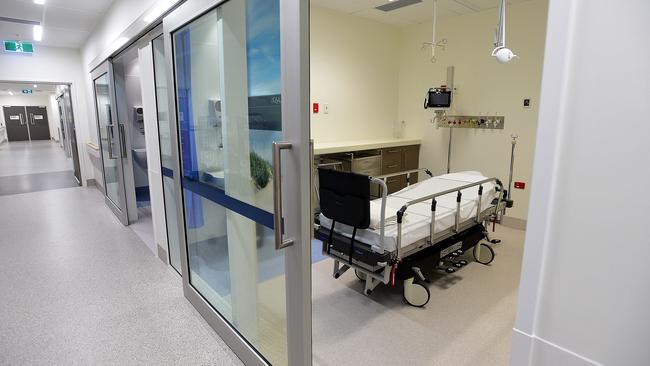
MRI
The RAH has two MRIs; new RAH has four MRIs.
PARKING
The old hospital has 1440 on-site car parks; new RAH has 2300 on-site car parks, 600 dedicated to visitors and patients. Plus storage for 300 bicycles, while tram, bus and train stops are nearby.
ADDITIONALLY
The new RAH has 70 internal courtyards, terraces and gardens; three wetlands walks; an Aboriginal garden; a retail precinct with florist, newsagent, hairdresser, gift shop, post office and bank facilities; indoor and outdoor cafes over three levels; touchscreen wayfinding kiosks in key locations for easy navigation; “hot lifts” for emergency transfers; automated vehicles delivering equipment including food via dedicated lifts (meals will be collected by staff from robots for serving to patients); and is a non-smoking precinct.
Shining a green light on sustainability
IT’S not just a colour. It’s the philosophy behind Adelaide’s state-of-the-art medical institution, writes Brad Crouch.
Good health and environmental care go hand-in-hand, so it is no surprise the new Royal Adelaide Hospital sets new standards as an environmentally sustainable and “green” hospital.
For starters the entire precinct is non-smoking — patients wanting to quit are invited to speak to staff about help available.
The site has 3.8ha of green space including three wetlands walks and an Aboriginal garden featuring local native species and art by indigenous artists.
Fresh air and natural light are major features of the hospital. There are 70 courtyards, terraces and gardens for peace and reflection at a time many patients and families may feel vulnerable and anxious.
There are also indoor and outdoor cafes over three levels.
Each inpatient room has windows that open to let in fresh air, with a variety of views including across to the Adelaide Oval. The window are low to allow views for patients lying in bed.
SA Health officials say sunshine and fresh air can have a positive impact on healing, physical recovery and mental heath.
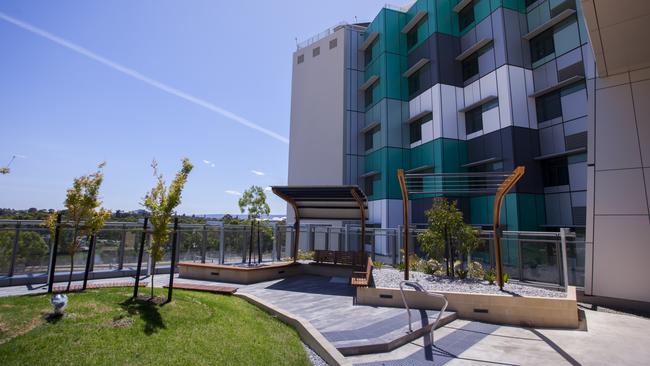
It is also expected to be of benefit to staff working in what is often a high-pressure job. Efforts to optimise the use of natural light mean a reduced reliance on artificial light — a benefit staff as well as visitors will appreciate. The solar passive design and orientation also takes advantage of the warmth of winter sunshine while minimising the harsh effects of summer sun.
Acoustic design will dampen noise in what is essentially a self-contained town with thousands of people on site, complete with visiting helicopters and ambulances.
High-efficiency water fittings have been fitted throughout the building, and recycled water will be used for toilet flushing and irrigation.
On-site generation systems will use waste heat to provide heating to the building, cutting the traditional large power bills of a major hospital. Extensive water and energy metering and reporting strategies are in place to identify and manage water and energy consumption.
The hospital also is designed around “a journey to health”, providing for short journeys between surgery treatment and recovery areas, and for clinical care to be brought to the patient in their bedrooms.
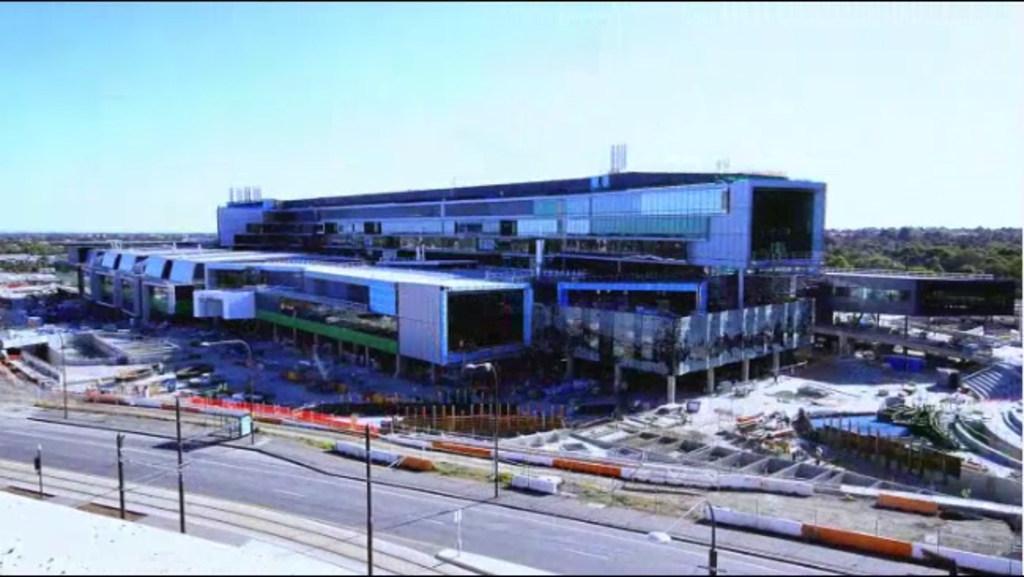
By the numbers
700 overnight beds (including 40 mental health beds)
100 same-day beds
1.6ha internal green space
2.2ha external green space
120 quiet staff work spaces
10 bariatric beds
70+ internal courtyards
1.3 million meals will be served per year
40 technical suites (operating, interventional and procedural rooms)
1800 Automated Guided Vehicles (AGVs) trips each day
4700 doors
500,000t of bulk excavation removed from the site
3000 soap dispensers
4000 fixed phones
550 portable phones
25 Automated Guided Vehicles (AGVs)
2500t of structural steel
300 bicycle parking bays
2300 car parking spaces
50 disabled parking spaces
150 motorcycle parking bays
2 helipad parking capacity
12,960t of concrete
40km of partitioning
25,000t of reinforcing
7x the size of SAHMRI
